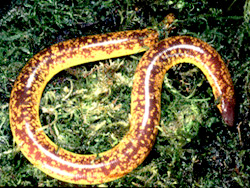


|
Rhinatrematidae:
The family Rhinatrematidae is made up of 2 genera and 9 species of medium sized caecilians (ranging from 161-328 mm) with true short tails (post-cloacal vertebrae present). Members of this family have primary annuli subdivided by secondary and tertiary annuli. Dermal scales occur in all annuli. The mouth is terminal (not countersunk as in more derived caecilians) and the tentacular opening is adjacent to the eye (considered to be the ancestral condition relative to its more anterior position in other caecilians). Members are ground color, grayish to purplish or lead gray; some exhibit a yellow lateral stripe. Their distribution ranges from northern South America through Brazil, Colombia, Ecuador, Peru, Surinam, Guyana, French Guiana, and Venezuela. Like most caecilians, these are found in tropical forests with dense forest litter and rotting vegetation. The presence of larvae indicates that they are egg layers. Rhinatrematids have partially open temporal regions (zygokrotaphy) on the skull. Zygokrotaphy along with a terminal mouth may suggest they are not highly specialized for burrowing. All caecilians have a dual jaw adducting mechanism, which is unique in vertebrates. In Rhinatrematids, the muscle is made up of one bundle (all other caecilian clades have two bundles).
Genus:
Epicrionops (8 species)
Rhinatrema (1 species)
|
